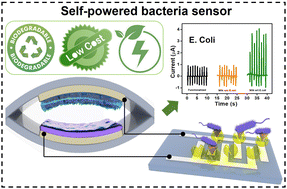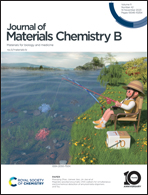Carbohydrate–protein interaction-based detection of pathogenic bacteria using a biodegradable self-powered biosensor†
Abstract
Battery-free and biodegradable sensors can detect biological elements in remote areas. The triboelectric nanogenerator (TENG) can potentially eliminate the need for a battery by simply converting the abundant vibrations from nature or human motion into electricity. A biodegradable sensor system integrated with TENG to detect commonly found disease-causing bacteria (E. coli) in the environment is showcased herein. In this system, D-mannose functionalized 3D printed polylactic acid (PLA) with the brush-painted silver electrode was used to detect E. coli by a simple carbohydrate–protein interaction mechanism. The adsorption capacity of D-mannose is generally altered by varying the concentration of E. coli resulting in changes in resistance. Thus, the presented biosensor can detect bacterial concentrations by monitoring the output current. The PLA TENG generates an output of 70 V, 800 nA, and 22 nC, respectively. In addition, tap water and unpasteurized milk samples are tested for detecting bacteria, and the output is measured at 6 μA and 5 μA, respectively. Further, the biosensor was tested for biodegradability in soil compost by maintaining constant temperature and humidity. This study not only proposes an efficient and fast method for screening E. coli but also gives important insights into the ability to degrade and long-term reliability of TENG-based sensor platforms.

- This article is part of the themed collections: #MyFirstJMCB and 2024 Journal of Materials Chemistry B Lunar New Year


 Please wait while we load your content...
Please wait while we load your content...